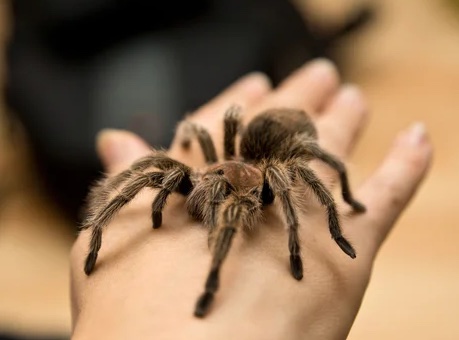Chilean Rose Tarantulas
Chilean rose hair tarantulas (Grammostola rosea and Grammostola portier), also referred to as Chilean fire tarantulas or just Chilean rose tarantulas are large spiders that reach a leg span of 5-6 inches. Their relatively long life spans, hardy nature, and reluctance to bite make them among the most common arachnid pets. These spiders are native to the deserts and scrubland of western South America, and are relatively recent to the pet trade, only becoming widely available in the 90s. Males generally live 4-5 years, but females can live 15-20 years.
These spiders are solitary, and should not be housed together.
ENCLOSURE
Chilean rose hair tarantulas are nocturnal, shy spiders, and do not require a large amount of space to roam. A 10 gallon aquarium with a screen lid is appropriate. Make sure the enclosure is not greater than a foot in height, as a fall within the enclosure could be dangerous for your spider. Make sure that you provide at least one hide within the enclosure. Small hollow logs or terracotta flower pots cut in half make appropriate hides, as do many reptile hides sold at pet stores.
SUBSTRATE
Chilean rose hair tarantulas are burrowing species, and require a deep substrate to burrow into. Provide at least 3 inches sphagnum moss, clean soil, or coconut husk fibers. This substrate should be spot cleaned when soiled, and be changed fully every 4-6 months.
HEAT AND LIGHT
Chilean rose hairs are primarily nocturnal and bright lights can startle them and dry out their enclosure. Ambient lighting in the room they are kept in is usually adequate. A nocturnal bulb of the purple/red variety can be used if the tarantula requires nighttime observation.
The ideal temperature zone is 75-85 °F. If the ambient temperature of your household is below this, a low wattage nocturnal bulb or an under tank heating mat may be used for additional heat.
DIET
Chilean rose haired tarantulas are primarily insectivores, and can be fed a variety of insects, such as crickets, waxworms, mealworms, and dubia roaches. Prey items should be no longer than the tarantula’s abdomen and should be gut-loaded before feeding. An adult spider should be fed 3-5 insects per week, split into 1 to 2 feeds. As Chilean rose haired tarantulas are nocturnal, they should be fed at night, and any uneaten prey should be removed the next day.
Chilean rose haired tarantulas may not eat for several weeks if they are getting ready to molt (see below). During these periods, continue to offer a single prey item once weekly to gauge your spider’s current appetite. If your spider does not eat for a month or greater, have it seen by a veterinarian.
WATER
Adequate hydration and humidity are necessary for proper health, particularly when it comes time for your Chilean rose haired tarantula to molt (see below). The humidity in the enclosure, as measured by a hygrometer, should be 65-75%. This can be achieved by using the appropriate substrates outlined above, misting the substrate when the humidity begins to fall below 70%, and by providing a water dish. If misting is necessary to maintain adequate humidity, avoid misting the spider itself.
The water dish provided should be easily accessible, and very shallow. Spiders breathe through openings on their underside and can drown in deep water bowls. Replace the water daily, and ideally use distilled or other chlorine-free water.
HANDLING CONSIDERATIONS
Chilean rose haired tarantulas are docile, and much slower to bite than many species, but are still venomous. Their bites are unlikely to cause significant harm to a human, and most bites will elicit only burning, pain, and itching at the bite site without further effects. However, in sensitive or allergic individuals the effects can be more severe.
Chilean rose haired tarantulas have fine, brittle hairs that can break off when handled, or can be actively kicked off by the spider as a defense mechanism. These hairs can cause skin and eye irritation. Some humans will have a greater reaction than others to these hairs.
As Chilean rose haired tarantulas are shy, solitary animals, limit yourself to only occasional handling. When handling, do so with a surface immediately under your hands, as should the spider slip, falling even a short distance can significantly injure your spider.
MOLTING
In order to be able to grow, and to replace its carapace as normal wear happens throughout its life, a Chilean rose haired tarantula must molt. This entails the spider shedding its old exoskeleton to reveal a soft, new exoskeleton that then hardens over the next few days.
Spiders that are molting are extremely fragile and should not be handled or fed during the molt, or for at least a week after. During a molt, a tarantula will lie on its back with its legs curled up underneath it. This can be very worrying for new tarantula owners to observe, but it is very important not to handle your spider during this time. The molt can last anywhere from 15 minutes to 24 hours. If the molt takes longer than 24 hours, contact your veterinarian.
Molting frequency is dependent on the age of the spider. Rapidly growing young spiders will require more frequent molts (as frequent as once monthly), whereas adult tarantulas will often molt only about once a year.
Signs that a spider is getting ready to molt include:
-A refusal to eat for up to several weeks before the molt
-A decrease in activity and slowing of movements
-Increased webbing in the enclosure
-Dull coloration
PREVENTIVE MEDICINE
Chilean rose haired tarantulas, particularly wild caught ones, can suffer from parasites. A veterinary consult can help determine if these are present.
Inadequate hydration and humidity can lead to difficult molting, which can be fatal, so be sure to follow the husbandry guidelines outlined above.
Trauma from handling, falls from enclosures that are too tall, or prey items left in the enclosure are also common, so practice good husbandry and handling to minimize the chances of injury.

